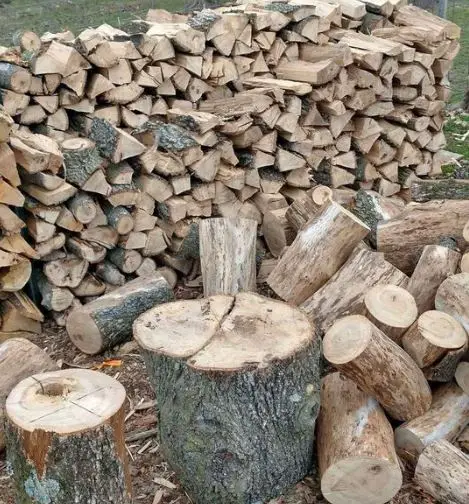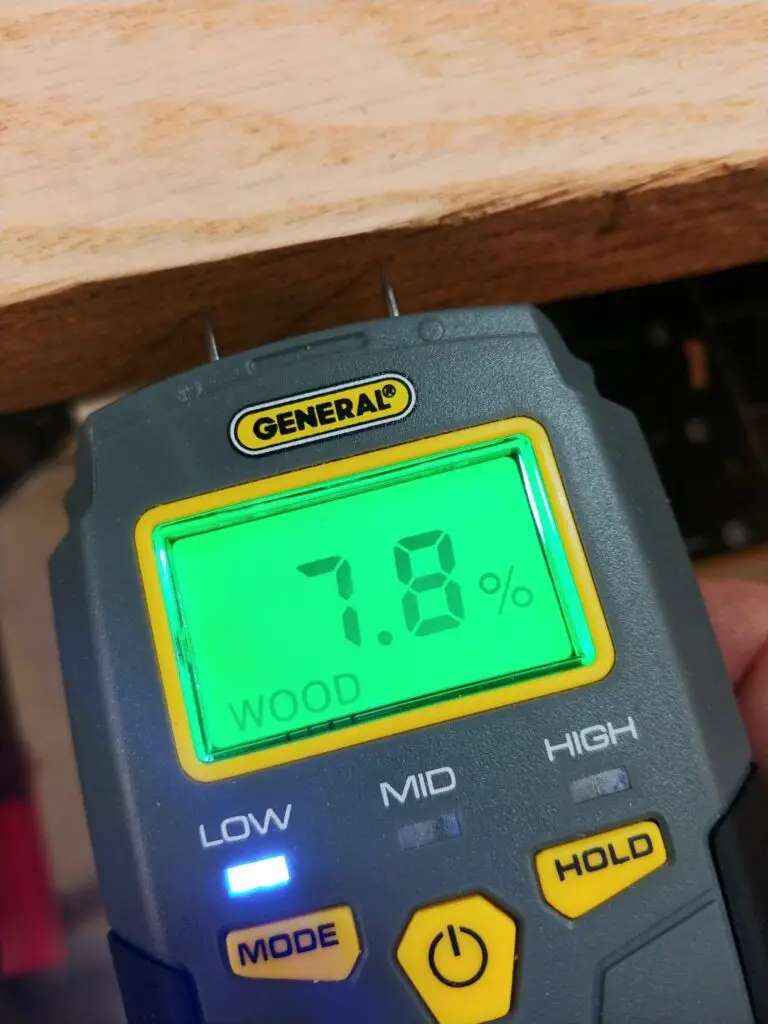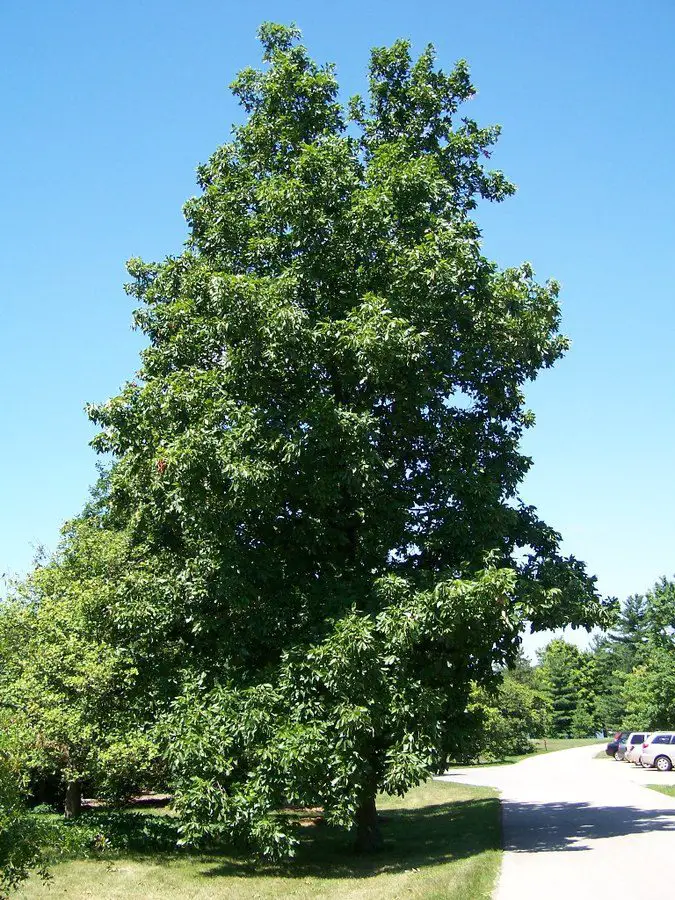Hickory firewood is one of the best burning options in North America because it produces around 27 million BTU/cord, which is in the top tier of all hardwood firewood. Hickory also produces one of the most famous smelling smokes and is popular for smoking meat and as a source of excellent cooking coals.
I wouldn’t hesitate to put hickory as one of my personal favorite firewoods and would gladly add it as one of my primary fuel sources for winter.
Table of Contents
Summary
- BTU: 27 million BTU/cord
- Seasoning Time: 12-24 months
- Splitting Difficulty: Difficult
- Sap Content: Low
- Smoke: Low
- Smell: Excellent
Overall, hickory is one of the best firewoods around. It produces a lot of heat but is also slow burning so you don’t need to restock the fireplace too frequently. The coals it produces are second to none, and gives an extremely stable temperature profile that is ideal for cooking. It is famous for its smokey smell, which is why you will find so many hickory smoked bacons and hams.
However, it does have some genuine downsides. The first is how long it takes to season, which can be anywhere from 12 months to 3 years, depending on the location’s weather and stacking techniques. I always make sure to split the wood into small enough pieces to bring this duration down. But it is also tough to split because of its high density.

Heat Production
Hickory is one of the best burning firewood because of its high heat production, its fantastic smell, and the slow-burning coals it generates. If you are looking for a cooking firewood or a smoking firewood, then hickory is your first choice. At 27 million BTU/cord, this is in the top tier of heat-producing woods, alongside oak. Compared to lower heat-producing woods like ash at 20 million BTU/cord, you only need to buy/stack 25% less hickory in your winter stockpile. This really helps to bring the price down.
Its high density also creates slow-burning coals with stable temperatures, making cooking meat much easier.
Smoke Production
Although hickory doesn’t produce a lot of smoke, it does bring a delightful smell. You will surely recognize the smell from all the hickory smoked meats you have eaten. If hickory is burnt unseasoned (green) then you will get some more smoke and popping from sap pockets igniting – I always recommend never burning firewood until it is fully seasoned to get the most heat production possible.
Seasoning Time
Hickory is a very dense hardwood, meaning moisture takes longer to seep out of the wood. It takes between 12 months and 3 years for hickory firewood to fully dry. This is heavily dependent on the location’s weather and the stacking method. Hardwood, like hickory, can take years to season, so stacking them correctly is essential to reducing this time. Make sure you stack your firewood in rows with sufficient airflow. Place a cover over the top of the stack to prevent rain from entering but leave the sides open for airflow and sunlight.
I personally recommend this General Tools Moisture Meter. It allows you to accurately gauge how wet your firewood is and whether it is sufficiently seasoned. Over time you can also see how quickly the moisture is dropping and how much longer you need to keep your firewood dropping until it is seasoned and ready to burn.
Press the sharp pins into the wood and you will quickly see the readout show the moisture ranging from 5% to 50%. It also has a Low/Mid/High indication depending on whether the wood is dry enough, so you don’t need to remember the actual values.

Burning Smell
Hickory wood is famous for being one of the best smelling firewood in North America. This is why it is so commonly used for smoking meat such as barbeque. If I am ever smoking meat, then hickory is my first, last, and only choice for firewood.
If the wood is fully seasoned then the quantity of smoke isn’t overpowering either, so you can happily burn it inside your home without causing any issues.
Creosote Buildup
Creosote is black soot that can build up in your chimney from unburnt wood. It is particularly common in softwoods with a high sap content, such as pine. This can cause chimney fires if enough creosote builds up. Hickory is a hardwood with a low sap content and doesn’t generate much creosote.
I still recommend cleaning your chimney regularly to eliminate the risk of fires completely, regardless of the type of wood you are burning.
Splitting
Hickory is an extremely dense wood that is renowned for being difficult to split. Hickory can also be very stringy, with hard-to-cut fibers holding it together. I wouldn’t try splitting hickory rounds without using an 8 lb splitting maul at the very least. If you have to process a significant amount of hickory at one time, then I recommend buying or hiring a log splitter – either electric or hydraulic is fine.
Different Types/Species
There are over 20 different species of Hickory tree that are native to North America. The five most common species are Shagbark, Bitternut, Pignut, Mockernut, and Shellback. Hickory trees can grow up to 100 feet tall over their 300-year lifespan. Hickory produces nuts that differ depending on their species but is useful in identification. Hickory trees are easy to spot from their scaley bark, which looks like they are constantly falling off.
Shagbark Hickory
Shagbark hickory is named after its bark, forming narrow strips peeling away from the trunk, giving mature trees a very unkempt appearance. They have a large canopy of leaves and edible nuts, making them the most popular species.
- Heat Production – 27.7 million BTU/cord
- Height – 60-80 feet
Bitternut Hickory
Bitternut hickory is easily identifiable due to its bright yellow buds in winter. The nuts they produce are inedible, and their bark doesn’t peel.
- Heat Production – 26.5 million BTU/cord
- Height – 50-70 feet
Shellbark Hickory
Shellbark Hickory, also known by its scientific name Carya laciniosa, has the largest nuts of all hickory species. They have slender trunks and grow in wet forests. They have become rarer recently because their large size doesn’t make them popular in urban environments.
Heat Production – 27 million BTU/cord
Height – 75-100 feet
Pignut Hickory
Pignut has a straight trunk with bark that doesn’t peel away from the trunk. They have huge canopies of leaves, making them popular with landscapers and gardeners. The nuts are bitter and aren’t nice to eat.
Heat Production – 27 million BTU/cord
Height – 50-60 feet
Mockernut Hickory
Mockernut trunks have long, narrow furrows from the bark. Also known as white hickory, mockernuts have a yellow/green leaf and a nut that is more difficult to crack
Heat Production – 27 million BTU/cord
Height – 50-60 feet

Comparison to Other Woods
Here, I’ve taken some of the most popular firewoods to burn indoors and compared them to hickory firewood.
You can see from the table below that hickory ranks highly compared to the most popular oaks. I believe it smells nicer than oak but is more difficult to chop.
| Firewood | Million BTU/Cord (source) | Ease of Splitting | Coals | Overall Quality |
| Green Ash | 20 | Easy | Good | Excellent |
| Maple | 25 | Easy | Excellent | Excellent |
| Bur Oak | 26 | Easy | Good | Excellent |
| Hickory | 27 | Difficult | Excellent | Excellent |
Hickory firewood is one of my favorite options for burning both indoors and outside. It has a high heat production and smells great, but its downsides are its long seasoning time and difficulty in splitting.
FAQs
Can you burn hickory wood in a fire pit?
Yes, hickory firewood is ideal for burning outside in a fire pit. It burns hot and slow, which you will feel throughout your campsite. It will stay burning overnight and will leave coals in the morning that are easy to stoke or to cook on. Its temperature profile in the coals is stable and is one of my favorite woods to cook with.
Can you burn hickory wood in a wood stove?
Yes, hickory firewood is ideal for burning inside in a wood stove. It produces a lot of heat which will keep your home warm all winter. The smell is delightful, and the amount of smoke generated is not overpowering. It also doesn’t produce much creosote so your chimney condition will stay cleaner for longer.
How much does hickory firewood cost to buy?
Hickory is a premium firewood and comes with a premium price tag. Hickory firewood will cost between $300 and $500 per cord, depending on the season and its availability in your county. You can buy bundles of hickory firewood for $6-$7. I believe that hickory is worth the higher price tag because of the heat production you get – you don’t need to buy as much to heat your home this winter. If you want to compare prices to other alternatives, I have put together this table showing different firewood costs.
Final Thoughts
Hickory is a top-tier firewood and justifies its price tag. It is my favorite smelling smoke and is ideal for cooking and smoking meat. It can be difficult to split, but this is nothing that a heavier axe or hydraulic log splitter can’t help with. If you get your hands on a hickory tree to process into firewood, then jump at the opportunity.
